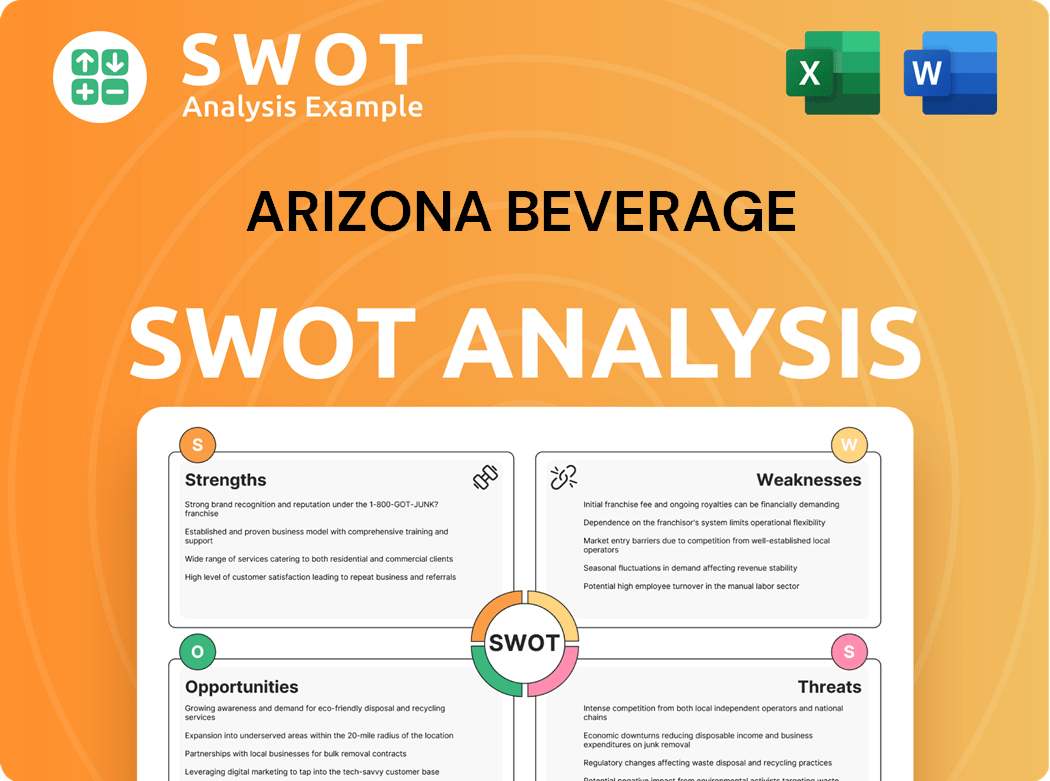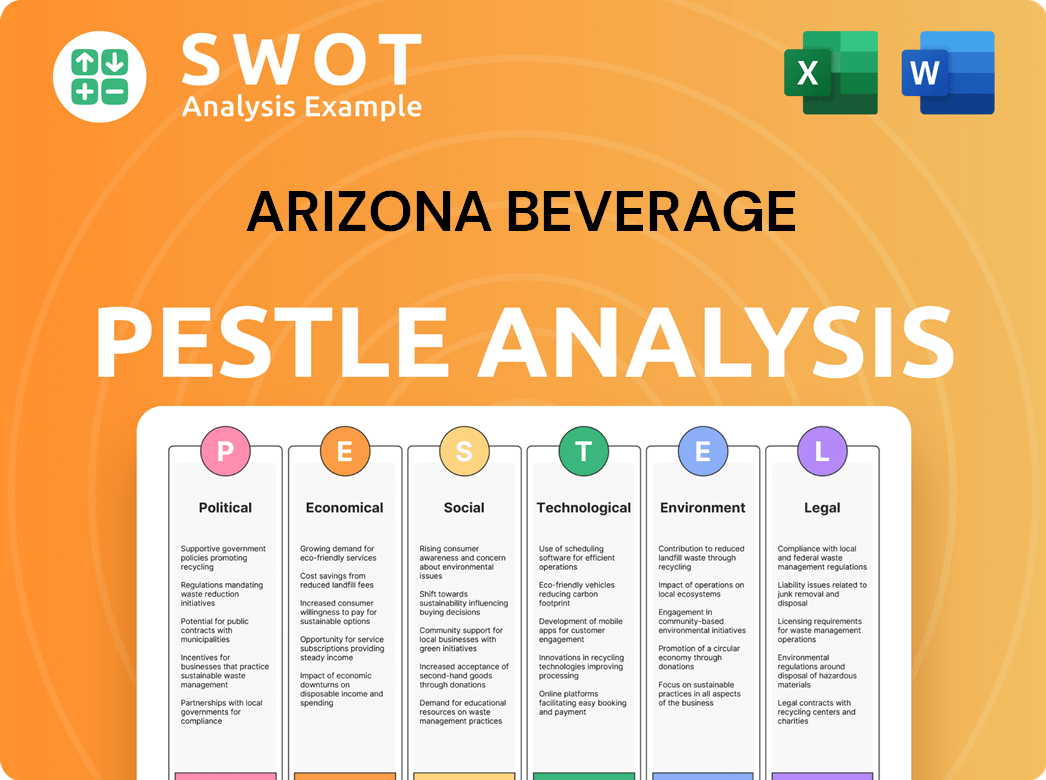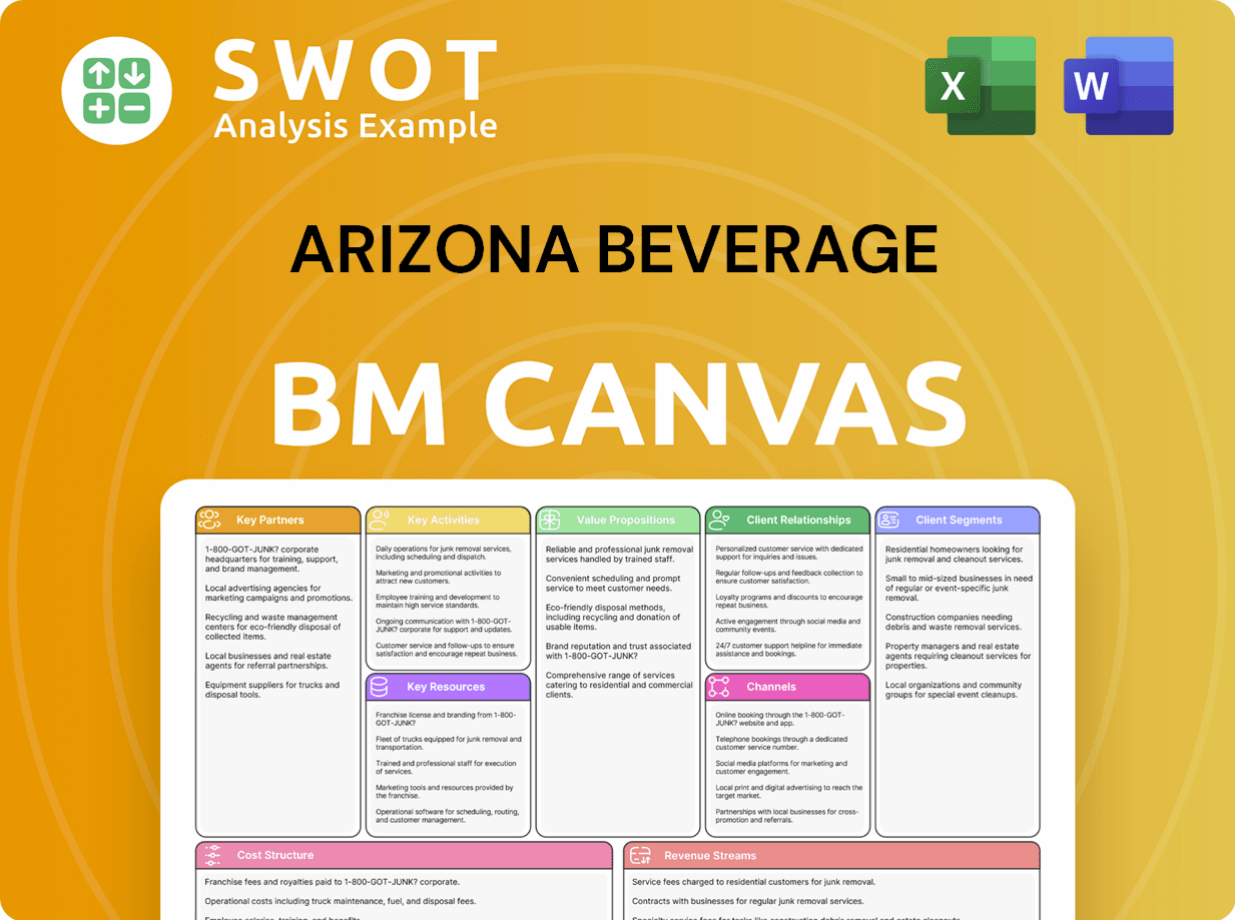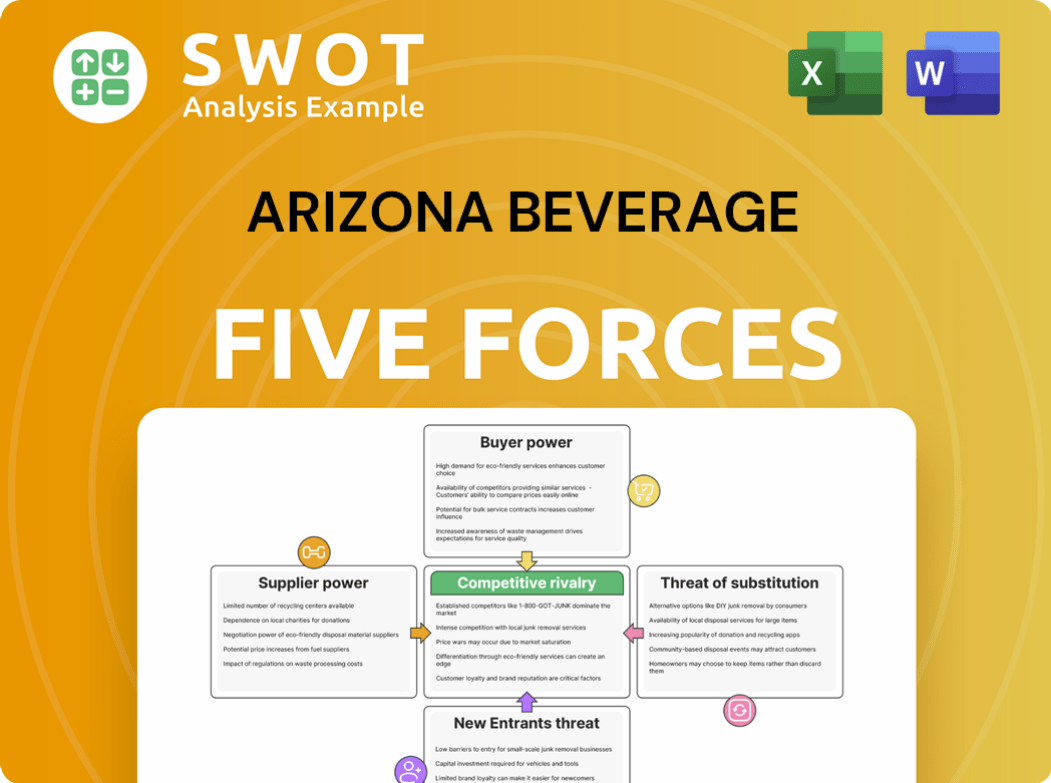Arizona Beverage Bundle
Can Arizona Beverage Company Maintain Its Reign in the Thirsty Beverage Industry?
The beverage industry is a battlefield, constantly reshaped by consumer tastes and market dynamics. Arizona Beverage Company, with its iconic large cans and affordable pricing, has successfully navigated this landscape. But how does Arizona stack up against its rivals, and what strategies keep it ahead?

Understanding the Arizona Beverage SWOT Analysis is crucial for grasping its position within the competitive landscape. This market analysis will dissect Arizona's key competitors, evaluating their strengths and weaknesses, and providing insights into the Arizona Iced Tea brand's strategic advantages. By examining Arizona Beverage Company's market share, distribution channels, and brand positioning, we'll uncover the factors driving its success and the challenges it faces in this dynamic sector.
Where Does Arizona Beverage’ Stand in the Current Market?
Arizona Beverage Company carves out a significant niche within the ready-to-drink (RTD) beverage market, particularly in the iced tea and juice sectors. The company's focus on affordability has been a cornerstone of its strategy, allowing it to capture a substantial share of the price-conscious consumer base. Its extensive product lines, including a variety of iced teas, fruit juices, and flavored waters, cater to a broad audience seeking value and flavor.
The geographic reach of Arizona Beverage Company is extensive across the United States, with products readily available in numerous retail channels, from convenience stores to supermarkets. This broad distribution network supports its market position, ensuring widespread accessibility for consumers. The company's ability to maintain a strong presence in channels where affordability and convenience are key drivers, such as convenience and dollar stores, further solidifies its market standing. To understand more about the company's operations, you can explore the Revenue Streams & Business Model of Arizona Beverage.
While precise, up-to-the-minute market share data for Arizona Beverage Company is not consistently published due to its private ownership, its consistent presence and widespread distribution suggest a robust operational model. The company's focus on the value segment has allowed it to compete effectively against much larger corporations. This competitive approach has enabled Arizona to maintain a strong position in the beverage industry.
Arizona Beverage Company holds a notable position in the RTD beverage market, especially in iced tea and juice. Its brand positioning centers on offering affordable, flavorful options, which has helped it capture a significant market share. The company's focus on value has allowed it to compete effectively against larger corporations.
Arizona's products are widely distributed across the United States through various retail channels. This includes convenience stores, supermarkets, and dollar stores, ensuring broad accessibility. The company's strong presence in these channels supports its market position by providing convenient access for consumers.
The company offers a diverse product portfolio, including iced teas (green tea with ginseng, sweet tea), fruit juices, and flavored waters. This variety caters to a broad consumer base seeking different flavors and preferences. Arizona's product range supports its market position by offering something for everyone.
Arizona Beverage Company's competitive strategy revolves around providing value for money. This focus has enabled the company to effectively compete with larger players in the beverage industry. Its commitment to affordability has been a key factor in its sustained market presence.
Arizona's key strengths include a strong brand recognition, extensive distribution network, and a focus on value pricing. This strategy has allowed the company to maintain a significant market share. The company's ability to adapt to changing consumer preferences while maintaining its core value proposition is also a key advantage.
- Value-for-money proposition, attracting price-sensitive consumers.
- Broad distribution across various retail channels, ensuring accessibility.
- Diverse product portfolio, catering to different tastes and preferences.
- Strong brand recognition, particularly among consumers seeking affordable options.
Arizona Beverage SWOT Analysis
- Complete SWOT Breakdown
- Fully Customizable
- Editable in Excel & Word
- Professional Formatting
- Investor-Ready Format

Who Are the Main Competitors Challenging Arizona Beverage?
The competitive landscape for Arizona Beverage Company, a key player in the beverage industry, is characterized by a mix of direct and indirect competitors. A thorough market analysis reveals that Arizona faces significant challenges from both established beverage giants and emerging brands. Understanding this competitive environment is crucial for assessing Arizona's market position and future growth prospects.
Direct competitors primarily include companies with similar ready-to-drink (RTD) tea and juice products. Indirect competition comes from a broader range of non-alcoholic beverages, including sparkling waters, energy drinks, and other alternatives. This multifaceted competitive environment demands that Arizona continuously innovate and adapt its strategies to maintain its market share and brand positioning.
Arizona Beverage Company's primary competitors are major players in the global beverage industry. These companies have substantial resources in terms of distribution networks, marketing budgets, and product portfolios. The competitive dynamics often involve shelf space battles and promotional pricing strategies in retail outlets.
PepsiCo, through its brands like Lipton Iced Tea and Brisk, is a significant direct competitor. PepsiCo's vast distribution network and marketing capabilities allow it to compete aggressively in the RTD tea market. PepsiCo's strong presence in the beverage industry poses a constant challenge for Arizona Beverage Company.
The Coca-Cola Company, with brands like Gold Peak and Peace Tea, is another major competitor. Coca-Cola's global reach and marketing power directly challenge Arizona's market share. Coca-Cola's diverse product portfolio allows it to compete across various beverage categories.
Keurig Dr Pepper, with its Snapple brand, is a key competitor in the RTD tea and juice market. Snapple's focus on unique flavors and brand image presents a direct challenge to Arizona's product offerings. Keurig Dr Pepper's market presence requires Arizona to continuously innovate its product lines.
Arizona also faces competition from smaller, independent beverage companies. These brands often focus on niche flavors or local appeal, creating a diverse competitive landscape. The rise of these brands requires Arizona to adapt its strategies to maintain its market share.
Indirect competition comes from healthier beverage alternatives such as sparkling waters, kombucha, and plant-based drinks. These products compete for consumer dollars that might otherwise be spent on Arizona's offerings. The growing consumer preference for healthier options poses a significant challenge.
Emerging players focused on functional beverages or sustainable packaging could disrupt the traditional competitive dynamics. These companies force Arizona to continuously innovate and adapt its product lines and marketing strategies. The focus on sustainability and functionality is a growing trend.
Several factors influence the competitive landscape for Arizona Beverage Company. These include distribution networks, marketing strategies, product innovation, and pricing. The ability to effectively manage these factors determines Arizona's success in the beverage industry.
- Distribution Networks: Efficient distribution is crucial for reaching consumers. Arizona competes with companies that have extensive distribution systems.
- Marketing and Branding: Strong brand recognition and effective marketing campaigns are essential. Arizona's brand positioning must compete with well-established brands.
- Product Innovation: Continuously introducing new flavors and product lines is vital. Arizona needs to adapt to changing consumer preferences.
- Pricing Strategies: Competitive pricing is essential to attract consumers. Arizona's pricing strategy impacts its market share.
For a deeper dive into how Arizona Beverage Company approaches its marketing, consider reading about the Marketing Strategy of Arizona Beverage. This article provides valuable insights into the company's tactics and how it navigates the competitive landscape.
Arizona Beverage PESTLE Analysis
- Covers All 6 PESTLE Categories
- No Research Needed – Save Hours of Work
- Built by Experts, Trusted by Consultants
- Instant Download, Ready to Use
- 100% Editable, Fully Customizable

What Gives Arizona Beverage a Competitive Edge Over Its Rivals?
The Arizona Beverage Company has carved a significant niche in the beverage industry, primarily through its distinctive brand identity and strategic market positioning. A deep dive into the competitive landscape reveals that the company's success hinges on a blend of factors, including brand recognition, pricing strategies, and an extensive distribution network. Understanding these elements is crucial for a comprehensive market analysis of Arizona's standing in the industry.
The company's approach to the market is characterized by its ability to offer high-quality products at affordable prices, which has resonated well with consumers. This strategy, coupled with its iconic packaging, has allowed the company to build a strong brand presence. The following sections will delve into the specific competitive advantages that have enabled Arizona to thrive in a highly competitive market, including its Arizona Iced Tea offerings.
Key to Arizona's success is its ability to maintain a strong presence across various retail channels, ensuring its products are widely accessible. This widespread availability is a critical factor in the impulse-driven beverage market. The company's operational efficiencies in large-scale production and distribution contribute significantly to its cost leadership, allowing for competitive pricing. These advantages have been consistently leveraged to maintain and enhance its competitive position over time.
Arizona's strong brand equity is a cornerstone of its competitive advantage. The company's iconic packaging, featuring large cans with vibrant designs, has created a unique visual identity that stands out on shelves. This distinctive branding has fostered significant customer loyalty, particularly among consumers who appreciate the brand's value proposition. This strong brand recognition helps in maintaining market share.
A key competitive advantage for Arizona is its aggressive pricing strategy. By consistently offering its products at affordable price points, Arizona has captured a substantial segment of the market that prioritizes cost-effectiveness. This strategy has allowed the company to achieve economies of scale in production and distribution, further reinforcing its ability to offer competitive prices, as noted in recent market analysis reports.
Arizona benefits from a robust and extensive distribution network, enabling its products to be widely available across various retail channels. This widespread accessibility is crucial in the impulse-driven beverage market. The company's distribution network spans major supermarkets to independent convenience stores, ensuring its products are easily accessible to a broad consumer base. This broad reach is a significant advantage in the competitive landscape.
While specific proprietary technologies or patents are not publicly highlighted, the company's operational efficiencies in large-scale production and distribution contribute to its cost leadership. These efficiencies enable Arizona to maintain competitive pricing while ensuring product availability. This operational excellence is a key factor in sustaining its market position and achieving favorable financial performance.
Arizona's competitive advantages are deeply rooted in its distinctive business model and consumer-centric approach. The company's focus on affordability and brand recognition has created a sustainable foundation for its market position. The ability to maintain competitive pricing while ensuring product availability is a key factor in its continued success.
- Brand Loyalty: The iconic packaging and consistent messaging have created a loyal customer base.
- Cost Leadership: The aggressive pricing strategy allows Arizona to capture a substantial market segment.
- Distribution Network: The extensive network ensures widespread product availability.
- Operational Efficiency: Efficient production and distribution contribute to cost leadership.
Arizona Beverage Business Model Canvas
- Complete 9-Block Business Model Canvas
- Effortlessly Communicate Your Business Strategy
- Investor-Ready BMC Format
- 100% Editable and Customizable
- Clear and Structured Layout

What Industry Trends Are Reshaping Arizona Beverage’s Competitive Landscape?
The non-alcoholic beverage industry, where Arizona Beverage Company operates, is experiencing significant shifts. These changes are driven by evolving consumer preferences, technological advancements, and increasing environmental concerns. Understanding these trends is crucial for assessing the competitive landscape and future prospects of Arizona Beverage Company.
The company faces both challenges and opportunities in this dynamic environment. Consumer demand for healthier and more sustainable products is reshaping the market. Simultaneously, growth in emerging markets and the rise of e-commerce present avenues for expansion and innovation. Navigating these complexities requires strategic adaptation and a keen understanding of the evolving industry dynamics.
The beverage industry is witnessing a surge in demand for healthier options. Consumers are actively seeking low-sugar, natural ingredient, and functional beverages. Sustainability is also a major driver, with a focus on eco-friendly packaging and practices. E-commerce and direct-to-consumer models are reshaping distribution channels.
Arizona Beverage Company faces the challenge of adapting its product portfolio to meet the growing demand for healthier options. Regulatory changes regarding sugar content and artificial ingredients could impact product formulations. The company's reliance on traditional distribution networks may be challenged by the rise of e-commerce. Sustainable packaging presents a significant challenge.
Expansion into emerging markets offers significant growth potential. Innovation in product development, such as introducing more unsweetened options and plant-based beverages, can attract new consumer segments. Strategic partnerships could open new distribution channels and product synergies. There is an opportunity to enhance brand positioning through sustainability initiatives.
To remain competitive, Arizona Beverage Company needs to balance its core value proposition with a focus on health-conscious offerings. Investing in sustainable practices and exploring diversified distribution strategies are essential. The company should consider strategic partnerships and continuous innovation to navigate the evolving competitive landscape. Adaptability is key.
The beverage industry is highly competitive, with major players like Coca-Cola and PepsiCo constantly innovating. Market analysis indicates that consumer preferences are shifting towards healthier options, creating a need for product diversification. Arizona Beverage Company's competitive landscape requires strategic adjustments to maintain and grow its market share.
- Product innovation to cater to health-conscious consumers.
- Investment in sustainable packaging and practices.
- Exploration of e-commerce and direct-to-consumer channels.
- Strategic partnerships to expand distribution and product offerings.
Arizona Beverage Porter's Five Forces Analysis
- Covers All 5 Competitive Forces in Detail
- Structured for Consultants, Students, and Founders
- 100% Editable in Microsoft Word & Excel
- Instant Digital Download – Use Immediately
- Compatible with Mac & PC – Fully Unlocked

Related Blogs
- What are Mission Vision & Core Values of Arizona Beverage Company?
- What is Growth Strategy and Future Prospects of Arizona Beverage Company?
- How Does Arizona Beverage Company Work?
- What is Sales and Marketing Strategy of Arizona Beverage Company?
- What is Brief History of Arizona Beverage Company?
- Who Owns Arizona Beverage Company?
- What is Customer Demographics and Target Market of Arizona Beverage Company?
Disclaimer
All information, articles, and product details provided on this website are for general informational and educational purposes only. We do not claim any ownership over, nor do we intend to infringe upon, any trademarks, copyrights, logos, brand names, or other intellectual property mentioned or depicted on this site. Such intellectual property remains the property of its respective owners, and any references here are made solely for identification or informational purposes, without implying any affiliation, endorsement, or partnership.
We make no representations or warranties, express or implied, regarding the accuracy, completeness, or suitability of any content or products presented. Nothing on this website should be construed as legal, tax, investment, financial, medical, or other professional advice. In addition, no part of this site—including articles or product references—constitutes a solicitation, recommendation, endorsement, advertisement, or offer to buy or sell any securities, franchises, or other financial instruments, particularly in jurisdictions where such activity would be unlawful.
All content is of a general nature and may not address the specific circumstances of any individual or entity. It is not a substitute for professional advice or services. Any actions you take based on the information provided here are strictly at your own risk. You accept full responsibility for any decisions or outcomes arising from your use of this website and agree to release us from any liability in connection with your use of, or reliance upon, the content or products found herein.